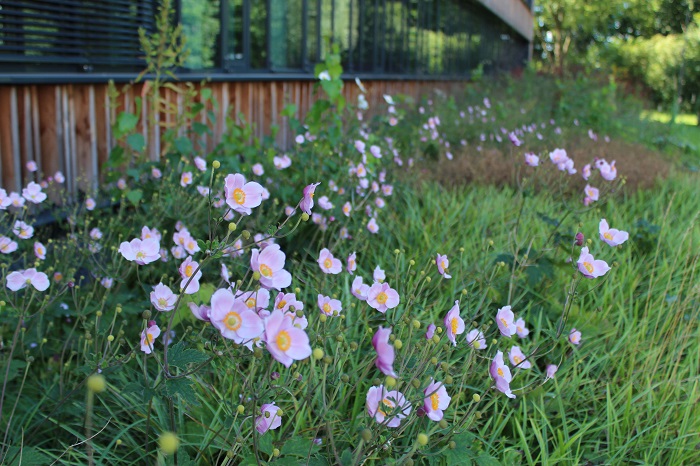Your selection
Research, Innovation, Patient care / 02.09.2022
With patience and a green thumb

Viola Ehrig is the green-thumbed gardener who works hard to ensure it’s not only science and innovation that flourish at the Berlin-Buch campus, but trees and flowers as well. She and her colleague Steve Kossack provide stimulating surroundings for everyone at the science campus, including employees of the MDC.
When she hears the crows kicking up a fuss at 4 a.m., Viola Ehrig knows the raccoon must be coming home. “I don’t yet know where it lives, but there’s certainly one hanging out around here,” she says. The gardener has worked for Campus Berlin-Buch GmbH since 2013; she and her colleague Steve Kossack are responsible for the green areas here on the campus.
In the summertime, Ehrig and Kossack’s working day begins as early as three or four o’clock in the morning. They load spades, shovels, rakes, hoses, and more onto their truck and then head out to where they are needed. The flowerbeds and trees must be watered in the early hours of the morning as there isn’t sufficient water pressure later in the day. And on hot days the moisture would immediately evaporate. It takes around two to three hours to give all the plants a drink. “A single tree needs as much as 120 liters,” says Ehrig.
Trees instead of graves
With grounds totaling 32 hectares, the Berlin-Buch campus recalls the expansive parkland of a manor house. Although a place of science, the campus is also an oasis on the edge of one of Europe’s biggest cities. Paths wind their way through the numerous green spaces between the research and administrative buildings. There are numerous trees and flowers, and the occasional sculpture. At one time, this site was intended to be a cemetery. Berlin’s Director of Public Gardens from 1910 to 1924, the landscape architect Albert Brodersen, planned to establish the “Buch-Karow Municipal Central Cemetery” here. The gatehouse, a service building (today’s Building A15, the Life Science Learning Laboratory), and a chapel had already been constructed when the discovery was made that the site’s water table was too high to bury bodies. So in 1925 a tree nursery opened here instead. Two Doric columns can still be seen where the chapel once stood, before it was demolished in the 1950s to make way for Walter-Friedrich-Haus (Building C27), and remnants of the tree nursery include the campus woodland and individual trees of unusual species for these parts – black locust, Canadian hemlock, cedar, and Jerusalem thorn.
Ehrig is acquainted with every single one. She knows when which trees were felled and when others were planted; where the deer graze at night; and where the two swarms of goldfinches that swoop across the campus like to spend their time – the answer is on the pile of chippings between the bike workshop and the gardeners’ office. Next to Building D23, which belongs to medical technology company Eckert & Ziegler, a large species of thistle is blooming. “Last year it was on the other side of the road,” says Ehrig. “Now it has spread over here. And of course we’ll leave it to grow.” The bushy purple flowers are a good food source for birds and insects. And thistles cope well in dry conditions.
A feast for the eyes – and the bees
Thistle do nicely! The prickly beauties perfectly fulfill the requirements of appropriate campus plants. These shouldn’t just be nice to look at; they should also help provide a good home for insects and other creatures. And they should be able to cope with increasingly warm summers. Outside Building D85 (Arnold-Graffi-Haus), the headquarters of Campus Berlin-Buch GmbH, and Building D82 (Karl-Lohmann-Haus), Ehrig and Kossack have laid out borders that are appealing to humans and insects alike. Here, day lilies bloom alongside phlox, lavender, sage, coneflowers, and hollyhocks. The colorful, fragrant flowers attract bumblebees, hoverflies, and butterflies as well as wild bees – and probably the campus’s very own honeybees, too! The hives outside the Life Science Learning Laboratory are home to two bee colonies. During school vacations, children can attend special “Bee Days” at the lab and learn all about the busy lives of bees and their crucial role in nature – as well as harvesting their own honey.
Our six-legged friends can also enjoy a veritable cornucopia outside Building D79 (Erwin-Negelein-Haus). Students at Eberswalde University for Sustainable Development planted a wildflower meadow here that includes wild strawberries, wild carrots, cornflowers, wild basil, motherwort, lesser burnet, and greater yellow-rattle. The seeds for the plants came from the Wildsamen-Insel in Schorfheide, a heath north of Berlin and west of Eberswalde. The meadow project is slated to last for five years, with ongoing scientific observation and analysis. The students are observing how the various plants reproduce and spread. “Our ideas of beauty must be redefined,” says Claudia Lühr, head of Campus Berlin-Buch’s facility management team. Carefully laid-out lawns and symmetrical rosebeds should now be consigned to the past. However, we don’t want to do without lawns entirely, as they are the perfect place for campus employees to relax and unwind. “Special events like barbecues or even just lunch breaks require mown surfaces,” says Lühr. “But we have to carefully consider where we can let nature take its course and where we intervene.”
Replenishing felled trees
During the 40 years of the German Democratic Republic, little work was invested in the campus woodland. It might sound good to let nature run wild, but it actually caused problems. “The trees are too close together,” says Ehrig. This is a remnant of the old tree nursery. Because springtime is getting warmer, the trees are sprouting leaves earlier in the year, which ultimately weakens them. After decades of neglect, many of the woodland trees are suffering from fungal infections and white rot. And oak processionary caterpillars are causing problems for the older oaks. “Sometimes you have to fell a tree or two,” says Ehrig.
Pankow’s environmental authorities regularly inspect the woods to ensure that the chainsaws aren’t employed too hastily. Dr. Christina Quensel, Managing Director of Campus Berlin-Buch GmbH, tells us that all landscaping work is carried out in close consultation with Eberswalde University for Sustainable Development and the Pankow Environment and Nature Conservation Office. “We have to get the office’s permission before a single tree can be felled, and for each one chopped down a new one has to be planted.”
“When we want to redesign an area of the grounds, we first present the plans to the campus management team,” Quensel continues. “Then a vote is taken involving representatives of every organization.” When some trees by Building B54, one of the guesthouses, were cut down because they were rotten with age and represented a danger, the group decided that a wetland biotope should be established in their place. Rainwater from the guesthouse roof and the road had always had a habit of gathering there. And so the depression in the ground was hollowed out further and lined with gravel so that the water wouldn’t seep away in the sandy soil. A small pond formed, which Ehrig and Kossack planted with bulrushes, yellow irises, and moneywort. Beside it they laid out a wildflower meadow, which is now home to cherry and pear trees as well as some rhododendron bushes.
Patience, the gardener’s greatest virtue
The poplars outside Building C32 (Max-Delbrück-Haus) also had to be felled after they began dropping deadwood and the roots were found to have infiltrated pipes and cable ducts. They, too, have to be replaced – preferably with trees from the “future trees list” drawn up by GALK, the association of German park managers. GALK currently recommends 65 tree species that are particularly resistant to drought, heat, frost, and pests. One species on the list is the catalpa; some of these were planted outside the campus cafeteria three years ago. Others are Juneberry, sweetgum, and mulberry. These are set to flank the BerlinBioCube once it is built. Tulip trees are another “tree of the future.” One is now growing alongside three trumpet trees. “In ten years or so it will have a dense crown full of tulip-shaped blossoms,” enthuses Ehrig. “It’s awesome. And all we need is a little patience.”
Patience will also be required when it comes to the princess tree that is growing in the courtyard of Building D9. When it reaches six to ten years old, in the spring it will sprout enchanting violet-blue blossoms that grow in upright clusters, rather like flowering horse-chestnut trees, and emit an intoxicating scent reminiscent of vanilla. The walls of the building protect the tree, providing good conditions for its growth. “Berlin’s continental climate is actually a little too cold for her,” says Ehrig, as if speaking of a dear friend. She has plenty to say about – and to – all her leafy friends here. When she whispers words of encouragement to them, it’s as if the plants perk up before our very eyes.
One person’s weeds are another’s heroes
Sadly, no amount of encouraging whispers will work for the plants by the artwork outside the Berlin Ultrahigh Field Facility (Building B88). Here, under a canopy of conifers, are narrow flowerbeds lined with metal edging, where mint and caraway are slowly wasting away. They are part of a sculpture by artist Ulrike Mohr, which stands outside the MDC’s Building 89 (Max-Rubner-Haus). The sculpture represents the molecular structure of carvone, a chemical found naturally in many essential oils, most abundantly in caraway and spearmint. “It’s a great idea,” says Ehrig. “But unfortunately mint and caraway have little chance of thriving in the shade of conifers.” What’s more, the plants regularly disappear from the beds. “Some people must be digging them up,” she says, shaking her head in disbelief.
What’s her favourite plant? She can’t answer that question; there are too many. “I love orderly chaos,” says Ehrig. She’s particularly fond of unassuming wild plants, the quiet heroes in a patch of garden. They help perennials to grow by casting shade and keeping the soil moist for longer. But now it’s time for Ehrig to leave the meadow outside Building C84, where a red squirrel is scampering merrily across the grass, and head back to the gardeners’ office. She has to draw up plans for tomorrow, which once again begins at dawn, just before the deer retreat into the undergrowth.
Text: Jana Ehrhardt-Joswig
Source: MDC
With patience and a green thumb
Overview News
News Buch Berlin
Towards understanding tumors in 3D
Researchers in Nikolaus Rajewsky’s lab at Max Delbrück Center combined high-resolution, single-cell spatial technologies to map a tumor’s cellular neighborhoods in 3D and identify potential targets fo...
more ...Max Delbrück Center to host Helmholtz Drug Discovery meeting
Top scientists and companies will meet in Berlin-Buch for the 2025 Helmholtz Drug Discovery Conference from April 28-30 to discuss RNA drugs, PROTACs, AI in drug discovery, and chemoproteomics and to ...
more ...Eckert & Ziegler Signs Contract Manufacturing Agreement for Yttrium-90-based PentixaTher with Pentixapharm
Eckert & Ziegler Radiopharma GmbH (EZR), a 100% subsidiary of Eckert & Ziegler SE, today announced the signing of a manufacturing agreement with Pentixapharm, a clinical-stage biopharmaceutical compan...
more ...Events Buch Berlin
13.05.2025, 17:00
Sprechstunde der Bezirksbürgermeisterin am 13. Mai auf dem Helmholtzplatz
Die Pankower Bezirksbürgermeisterin Dr. Cordelia Koch führt am Dienstag, dem 13. Mai 2025 von 17 – 19 Uhr ihre nächste Sprechstunde durch. Dazu trifft man sie an einem Stand am Helmholtzplatz, Ecke Ra...
more ...13.05.2025, 17:00
Einladung zum Auftakt des neuen "Jugend-MedienLabor"
Start des neueb Projekts Jugend-MedienLabor: Für Jugendliche, junge Erwachsene und alle, die Lust auf Austausch, Kreativität und neue Impulse haben
more ...13.05.2025, 18:00
Campus-Kino „Die Schwimmerinnen“
Der Freundeskreis des Max Delbrück Centers lädt ein
more ...






